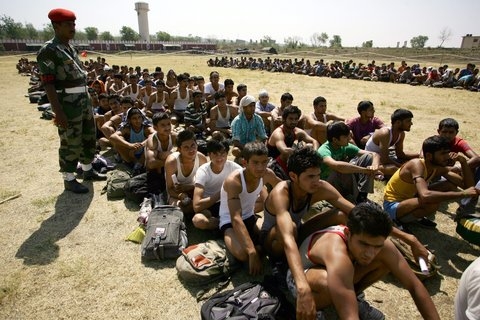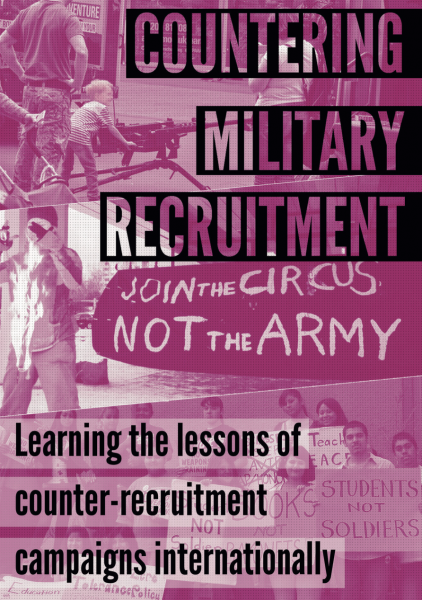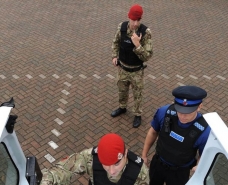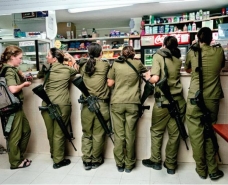Survey findings: Recruitment, and The military in public and private spaces

Recruitment
In the majority of the thirty-two countries surveyed[1], minors (those under 18 years old) cannot join the armed forces. However, there are multiple exceptions to this – such as the USA, France and Canada, whose military includes 17 year olds. In those countries that allow minors, there are often restrictions. In the UK, under-18s cannot serve in combat roles, and in Germany 17.5 year olds can join only with parental consent. In those states that do not officially allow minors to serve, this does sometimes happen nonetheless, for example in Israel and Colombia.
Many European states surveyed - Spain, Serbia, Macedonia, Germany and Sweden - fit the trend of numerous European states having abolished compulsory military service in the last 15 years. Austrians voted to keep it in a January 2013 referendum; a Swiss referendum will take place later this year. The vast majority of those surveyed countries with conscription recruit males only. All countries – with the exception of South Korea, Turkey, and northern Cyrpus – claim to offer the right to conscientious objection. However, it is often difficult to obtain. Outside of Europe, South Korea is the only country surveyed that does not provide for conscientious objection to military service. Compulsory substitute service exists in Paraguay, Switzerland, Russia, Greece, Finland, Austria and the Republic of Cyprus. In Cyprus, Finland and Switzerland, this substitute service is longer than the military service, contrary to international standards, which ensure that substitute service is not ‘punitive’ (including in terms of length). In Paraguay, if you wish to avoid this substitute service, you pay a daily fine.
A significant majority of countries ask their young people to register themselves for conscription. An anomaly is France: although there is no conscription, young people have to complete - usually between the ages of 16-18 - a ‘Defence and Citizenship day’ (otherwise they can't get a driving licence, or a degree).
Over two-thirds have local or national authorities that hand over young peoples’ information to the military. This varies in terms of how systematic it is. In nine countries, information is also passed from schools to the military.
Twenty-two of the countries are involved in active combat, mostly externally - sometimes as part of a wider multilateral force such as NATO – but internally in Colombia, Ecuador, Paraguay, and India, which is an example of non-state militarisation of youth.
There are a number of aspects of the military that are emphasised to the public, partly to facilitate recruitment by presenting the armed forces in a positive light:
-
Adventure: The military presents itself as providing adventure in its recruitment and other advertising in countries across all continents surveyed – although by no means all. In some, this appears to be a long-term tactic. In others, this is a recent or temporary policy. This is sometimes related to country-specific contexts, for example the Canadian armed forces emphasise how travel away from Canada otherwise is prohibitively expensive.
-
Humanitarian and aid work: In all but eight countries, the military also does humanitarian and aid work. In Paraguay, this is heavily emphasised; in Nepal it isn't, yet this remains the public’s perception of what they do.
-
The military brings peace: Twenty of the militaries promote the belief that the military brings peace. This manifests itself in different ways: in Finland, the strength of their army is believed to prevent Russian aggression, while in Canada, there exists a popular view that the army are essentially peacekeepers, not a ‘real military’.
-
The military defends you and your values: Overwhelmingly in Europe, and noticeable in all other continents, is the view that the military defends the country and its values. Again Canada is an exception, with the emphasis being on helping others (partly because there has not been military organised armed conflict in the state of Canada).
-
The military can be a career: In all but two countries surveyed - Turkish-administered Northern Cyprus and Nepal - this is one of the messages utilised.
-
The military will lead to future study or employment opportunities: Similarly, the potential garnered by a military career is highlighted in many countries. This link is more or less explicit: in Canada, the military pay university costs ($7000 tuition, $10,000 living expenses each year), and in Turkey you cannot get government jobs without having served in the military. In South Africa, this is perceived as the main attraction.
- Other: In the US, the focus is on good health and the good pay; the latter argument is also prominent in Macedonia. In Spain it is a way for immigrants to attain citizenship, and in India the role of the military in responding to riots and other internal problems is emphasised.
Notes
[1] Austria, Argentina, Belgium, Canada, Colombia, Cyprus (Republic of), Cyprus (Turkish-administered Northern), Ecuador, Finland, France, Germany, Greece, India, Ireland (Republic of), Israel, Kenya, Macedonia, Mozambique, Nepal, Norway, Paraguay, Russia, Serbia, South Africa, South Korea, Spain, Sweden, Switzerland, Tunisia, Turkey, UK, USA.
The military in public and private spaces
There is a mixed picture in terms of how much the military is visible on the streets. The ubiquity of some militaries is related to military service, whilst in other countries without conscription the presence of the military is limited to specific locations, for example train stations and near borders. Militarised actors like armed police are often present, in some countries where the military is not publicly visible (for example in the UK).
A minority of the countries have paramilitary or 'illegal' weapons visible on the street – in France, Paraguay and South Africa this includes 'security' personnel. Almost two thirds of the countries have heavy artillery in public spaces. This was mostly decommissioned, and for use in parades, with the exception of rural Switzerland and government building in Tunisia.
Five countries - Ecuador, Colombia, Switzerland, Israel, Finland – have bomb shelters in every building or street. Every single country surveyed – with the exception of Nepal – has streets or squares named after military figures of personnel. Mostly, these don't relate to recent conflicts.
All but three countries have military parades in public spaces, mostly on national holidays. In all but three countries that have an air force, the air force does exhibition flights. In Greece, the number of these has reduced since the financial crisis. In almost half of countries, members of the public (not including the family of military personnel) are allowed to visit military bases.
In twenty-three countries, the military has a presence at festivals and concerts, but the frequency of this varies. Slightly fewer – twenty-one – militaries actually organise their own festivals and concerts for the public. Only in Norway does the military not take part in national or religious or cultural celebrations. Twenty-seven countries also have monuments dedicated to military personnel in public spaces.Survey findings: Recruitment, and The military in public and private spaces
18 Jul 2013 — Owen Everett
Countering Military Recruitment

WRI's new booklet, Countering Military Recruitment: Learning the lessons of counter-recruitment campaigns internationally, is out now. The booklet includes examples of campaigning against youth militarisation across different countries with the contribution of grassroot activists.
You can order a paperback version here.








